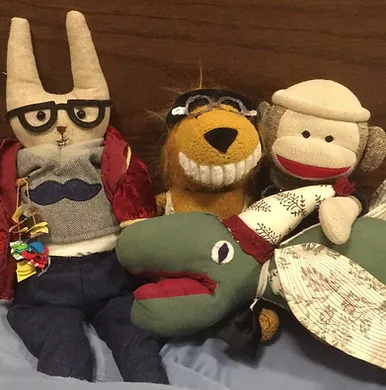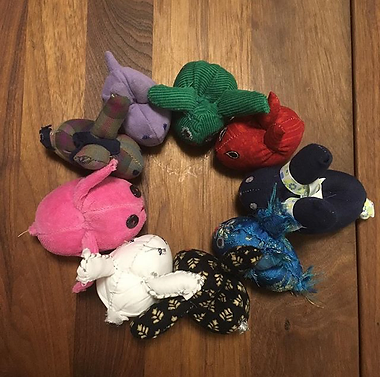Meet Conner Singh VanderBeek: Ethnomusicologist, Artist, Composer, and Stuffed Animal Enthusiast
- Lucie

- Jan 23, 2022
- 7 min read
Ethnomusicology is the study of music, especially from cultures that are non-Western. Ethnomusicology analyzes the cultural importance of music to a society and compares the structures and elements of music from around the world. Ethnomusicology is a relatively new academic discipline (circa 1950), merging musicology (the study of music), with ethnology (the study of different cultures). As classical music students, world music isn't often stressed within the K-12 music curriculum and programs, so it's important to learn and appreciate other genres besides traditional Western music. I had the chance to interview Conner Singh VanderBeek, an ethnomusicology doctoral student and media artist, who unites his cultural heritage for his passion for composition and performance through multiple instruments and formats. All images used in this story are from Mr. VanderBeek's website.

What instruments do you play, and what initially started your journey into music?
My parents had a 45-key digital keyboard that plugged into an educational program on our black and white Macintosh computer. I started learning piano on that program at 6 or 7 years old. Even though the Miracle Piano Teaching System that I was using taught how to read music, I learned the songs in the program's repertoire by ear. My second-grade teacher, Kathleen Heinzinger, then suggested to my parents that I take piano lessons, and I had my first lesson with Pam Tallman in early 2000. I was so committed to learning piano that first year of lessons that my parents had to buy me a grand piano later that year. Since my undergrad, I've picked up harmonium, accordion, Javanese Gamelan, a little bit of tabla, and electronic music. How has your personal background of being multi-ethnic influenced your research and art?
When I was a kid, my mom worked tirelessly to make sure my brother and I retained our Punjabi language and heritage, but that is an extremely daunting task when you grow up speaking only English in school and with friends. I was afraid I would lose touch with my Punjabi side when I left home to do my undergrad at Northwestern, so I studied the closest thing I could find there to Punjabi -- Hindi. During my third year, I took Field Methods in Musicology with Professor Inna Naroditskaya, who suggested I go to the Sikh Temple of Chicago on Devon Ave.
Nearly every research or art project I've taken on since then has started with me noticing a group of people knowing something I don't know and asking how they came to know that -- whether that was Sikh sacred music, Punjabi language, or various events from Indian and Punjabi history. The experiences I have had as a half Punjabi have given me the curiosity to learn more about my heritage but also constantly remind me that there are always people who are more knowledgeable about and more embedded in the community than I am. How did your focus in music change, or evolve during your time as a high school, college, and graduate student? Did you expect to end up where you are today?
When I was in high school, I wanted to become a concert pianist. When I tried ramping up my practice routine midway through high school, I unfortunately ended up injuring myself. I had been composing music with some regularity as early as fifth grade, but composition became a huge musical crutch for me during the months I could barely play any piano at all. I entered Northwestern then intending to be a composer, then I took on a double major in musicology after studying with Professor Naroditskaya.
By the time I was applying to grad school, I had three directions I could go based on my three majors -- composition, musicology, and South Asian studies. I applied to programs in all three areas and ended up getting into the PhD Program in Ethnomusicology at University of Michigan, where I am today. I always knew from when I was 8 years old that I wanted music to be a central part of my life, but I had no idea it would be such a winding and dynamic path. Have you had any study-abroad experiences during your education, and how have any of these experiences shaped your learning and intellectual curiosities?
I studied abroad in Delhi, India, for the fall 2014 semester, where I took part in a program on national identity in the arts. I would spend a month of that project in Punjab on an independent research project. I was able to visit the most sacred sites in the Sikh faith, and I even spent a few days in my family's ancestral village. Going to India had been part of my undergraduate plan since I declared a South Asian studies major, but that experience was a total affirmation of my scholarly and personal path. What themes or ideas do you explore in your musical compositions?

I became severely depressed during my time at Northwestern, and so I spent several years exploring depression and mental illness in my music. In recent years, my projects have delved into aspects of my personal (i.e., moving to a new place every 2-3 years) or elements of Punjabi, Sikh, and/or Indian history. My friend Christopher Gomez and I also have a noise duo called Sphincter Control where we confront themes like underpaid labor and American fascism. What are some of your greatest influences that inspire you in your work as an ethnomusicologist and media artist?
My greatest influences are the people closest to me: my mom, who has had to navigate cultural retention and loss her whole life in America, my late grandfather, who was a farmer and acclaimed Punjabi poet and short story writer, my partner Simranpreet Anand, who is an incredible visual artist, curator, and person.
I've also had the great honor of collaborating with some incredibly talented friends over the years -- David Alejandro Hernandez, my middle school best friend who is an incredible poet, Lynn Hong, a filmmaker and video artist I met at Northwestern, Kiran Bhumber, a sound and new media artist I met at University of Michigan who is based in Vancouver, and Chris Gomez, the other half of my noise duo. Each person I collaborate with challenges me to break outside of my artistic comfort zone and to pick up new skills and mediums. I read on your website that much of the research you have conducted is regarding the Punjabi diaspora and Sikh identity. How have your skills in music and video creation enabled you to explore these topics more deeply?
As a scholar and researcher, there's a lot of material that doesn't make it into writing -- sights and sounds, personal connections, incredible moments. Arts gives me the space to fill out and process those experiences, but also to connect with fellow artists. I maintain that the best scholars in the arts are people who also create and share work, since they never get detached from living through their craft. I also try to learn the styles of art and music that I encounter in my research so that I can better understand the creative worlds that other people come from.
Do you personally have a favorite project that you have created?
Every project I take on becomes my favorite. That includes my two big audiovisual works, 9 pieces for piano and electronics and On the condition of being multiple places, the song cycle David Alejandro Hernandez and I wrote called The way they understood themselves, and, most recently, the sculptural and mixed media body of work Simranpreet Anand and I created that explores the life cycles of Sikh sacred textiles, ਬੰਦੇ ਚਸਮ ਦੀਦੰ ਫਨਾਇ ॥ Bande chasm deedn fanaai ||. Lately, I've been working on a series of educational videos on Javanese Gamelan that my colleagues in the ethnomusicology department filmed last year. I got into Gamelan during my time at U-M, and it has been such an unexpected and wonderful part of my musical life.
Tell us about your work as a stuffed animal artist. What role do your stuffed animal creations play in your art?
I grew up with a deep emotional attachment to my stuffed animals, and I learned how to sew in middle school. I got really depressed the year after I graduated from Northwestern and took up sewing to make something good out of a period where I spent most of my time getting slowly absorbed into my parents' couch.
From sewing, I've gotten into
embroidery and weaving, which have been really important facets to my work as a collaborative artist. I also make stuffed animals for friends and family, and I hope that these creations can give people the kind of pure joy that my stuffed companions have given me. One of the iconic stuffies is Gruntwinder, a green dinosaur with quilted wings and a hat who has his own Instagram.
What advice would you give to a young student in elementary or middle school trying to explore the possibilities of a career in music?
Branch out. Very few of us can have careers where our main source of income is performing, but that doesn't mean we have to make music any less important a part of our lives. Try your hand at teaching, writing, doing studio work, learning new instruments, and, most important, collaborating.
"Branch out. Very few of us can have careers where our main source of income is performing, but that doesn't mean we have to make music any less important a part of our lives."
Where do you plan on going in the future with your career?
I would like to balance being a scholar and pedagogue with continuing to be an artist and musician. I'd love to end up back on the west coast so my partner and I can be close to our families and that I can finally leave Midwestern winters behind me. But no matter where I end up, music has to be a central part of my life.
















Comments